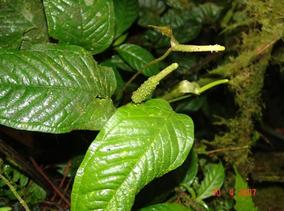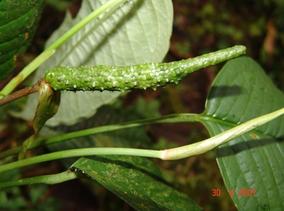Araceae
Anthurium Schott
SUMMARY
HABIT : evergreen herbs, stem erect, creeping, or short- to long-climbing, rarely rhizomatous, internodes very short (plant rosulate) to elongated. LEAVES : prophylls and cataphylls usually ± persistent, entire (membranaceous) or rotting to a fibrous mass (net-fibrous), sometimes completely disappearing. PETIOLE : geniculate apically (geniculum rarely well below blade, e.g. A. oerstedianum), variously shaped in cross-section, sheath long in juvenile (monopodial) leaves, very short in sympodial leaves. BLADE : small to very large (exceeding 2m), usually coriaceous, more rarely membranaceous or stiff and brittle, extraordinarily variable in shape, linear to orbicular in outline, rarely peltate, entire to trifid or trisect, or pedatifid or subpalmatifid, or pedatisect to radiatisect, rarely the lobes or segments themselves pinnately lobed, blade base cuneate to cordate, sagittate or hastate; primary lateral veins pinnate or more rarely all arising at the base, usually forming one or more submarginal collective veins, basal ribs often present in cordate leaves, higher order venation reticulate. FLOWERING BRANCHES : sympodial units usually comprising one 2-keeled prophyll, one 1-keeled cataphyll, one foliage leaf and terminal inflorescence. INFLORESCENCE : always solitary. PEDUNCLE : usually rather elongated, rarely short. SPATHE : usually persistent, sometimes marcescent or deciduous, usually linear to linear-lanceolate, more rarely elliptic to ovate, broadly cordate to suborbicular, erect, spreading or reflexed. SPADIX : sessile to long-stipitate, usually cylindric to conic, more rarely clavate, rarely globose, very short to very long (over 1m). FLOWERS : bisexual, perigoniate; tepals 4, fornicate, in 2 decussate whorls. STAMENS : 4, filaments somewhat flattened, usually equalling tepals at anthesis, sometimes exceeding them, anthers short, connective slender, thecae ovate to oblong-ovate, dehiscing by longitudinal slit. POLLEN : forate (most often 3-4 pores), more rarely diporate, rarely inaperturate (sect. Polyphyllium), spherical to subspheroidal, small (mean 22 µm., range 14-29 µm.), exine foveolate to reticulate or subrugulate, rarely tuberculate, muri ± psilate or spinulose, apertural exine mostly psilate, rarely spinulose. GYNOECIUM : ovary ovoid to oblong or obovoid, 2-locular, ovules 1-2 per locule, rarely more, anatropous, hemianatropous or subcampylotropous, funicle short, placenta axile near apex of septum, style inconspicuous to attenuated; stigma small, subcapitate, secreting conspicuous nectar droplet at anthesis. BERRY : variously shaped from globose to elongate-fusiform, when mature exserted from tepals and usually held dangling by tiny strips of inner tepal epidermis, sometimes simply falling out of spadix, 2-4-seeded (more in sect. Tetraspermium), variously coloured, from conspicuous reds and oranges to dull purplish green, white or blueish. SEED : ± oblong to ellipsoid or subglobose, sometimes curved, testa usually smooth or somewhat verrucose, thin, usually with sticky gelatinous mass adhering to raphe, small strophiole sometimes present, embryo axile, subcylindric to conoid, sometimes curved, endosperm copious.





